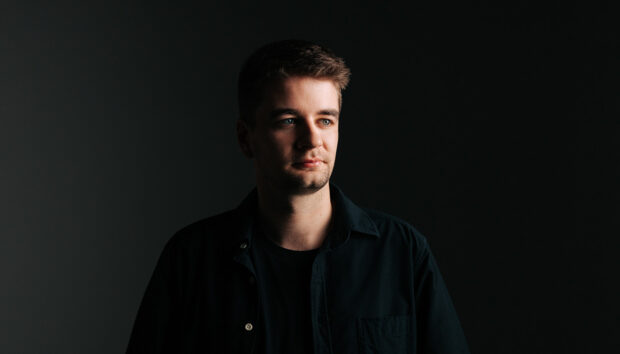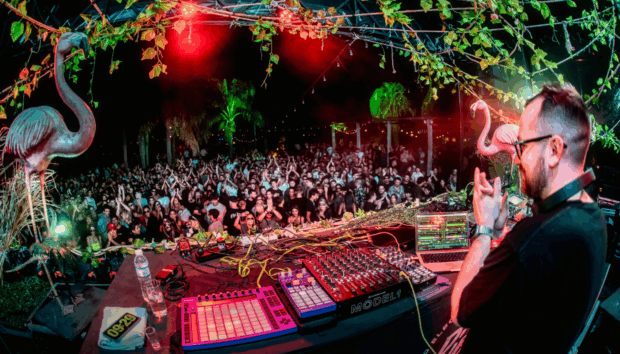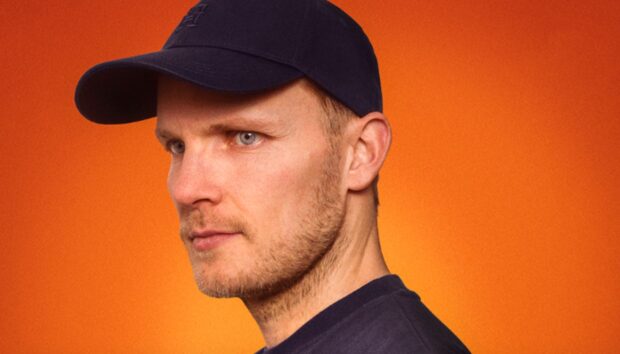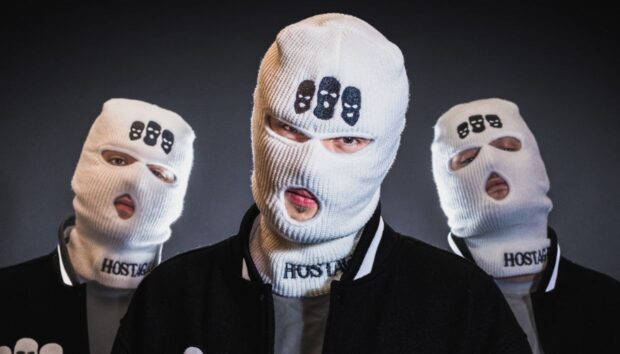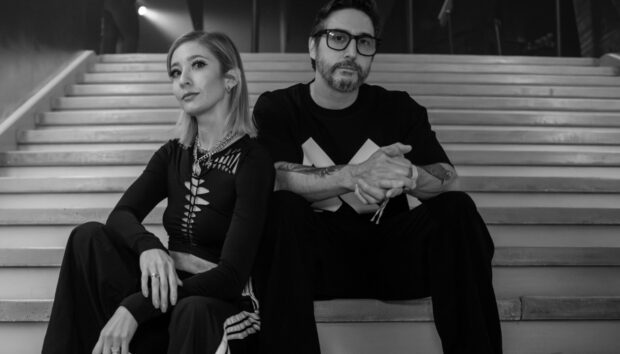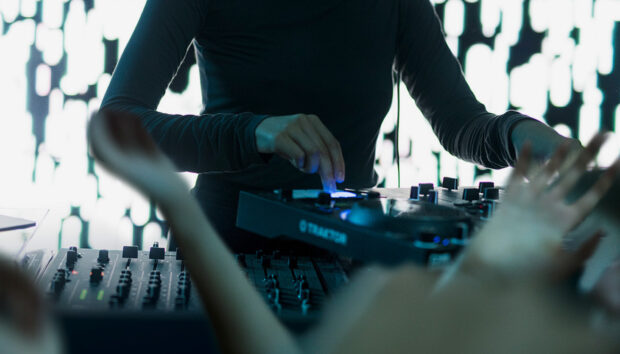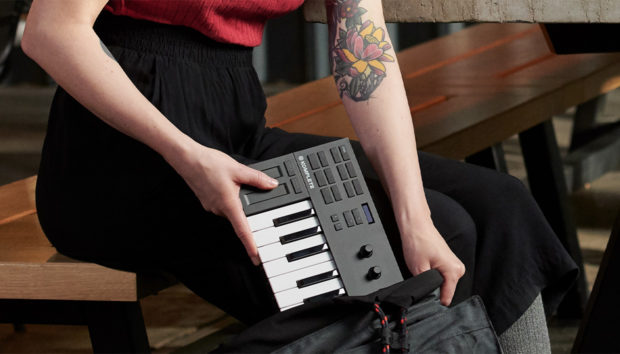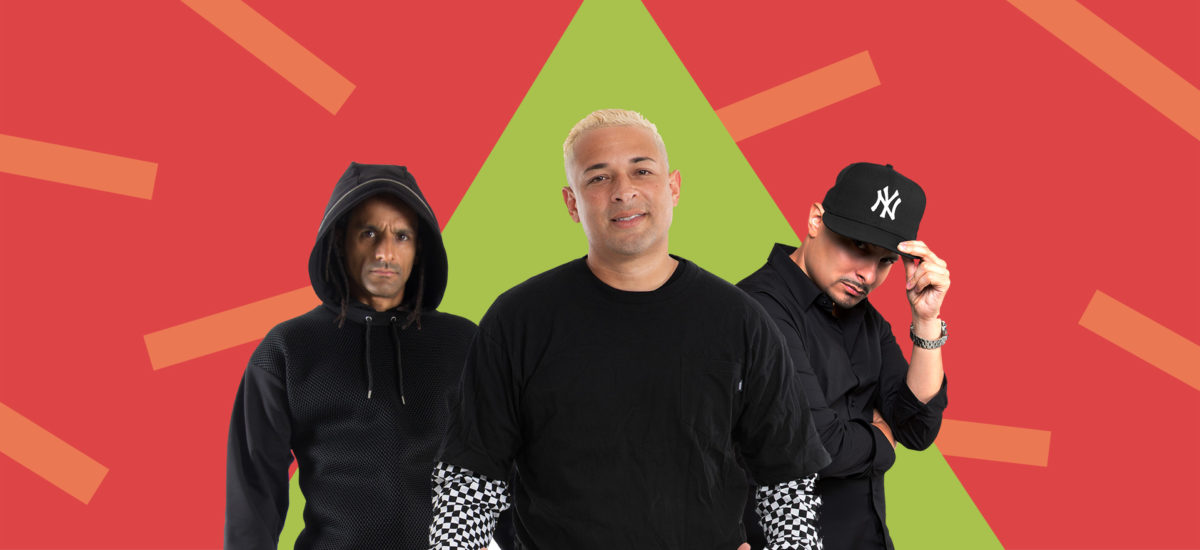
The digital age may have opened a veritable Pandora’s box of online phenomena, for better or worse. But one truly great thing that the convenient nexus of social and streaming brought to our lives has been the music, presenting the world with unprecedented access to sounds and scenes often seemingly impenetrable or inaccessible to outsiders. Nothing illustrates this quite like the explosive growth of música urbana, the catch-all term that includes reggaetón, into the global mainstream.
Together and individually, DJ Nelson, MarioSo DeJesus, and Huey Dunbar played a vital role in the emergence, development, and, notably, the commercial success of this music, earning critical accolades and international awards along the way. As a co-founder and force behind the Puerto Rican collective known as The Noise, DJ Nelson cultivated reggaetón from the ground up, dropping definitive mixtapes and Luring Recording Engineer DeJesus and singer-songwriter Dunbar from New York to his vibrant studios on the island. Both in spirit and in practice, their past and present contributions to all manner of Spanish-language hip hop, R&B, and pop mattered, and continue to do so to this day as seasoned power players with a personal stake in furthering the movement.
After some chance encounters with Native Instruments during NAMM, the opportunity arose to capture these accomplishments and share them with the next generation of producers. In light of their participation in making bespoke Latin sound packs, we spoke with all three production and songwriting living legends about their come-ups and their craft.
How did you first get started in this business?
DJ Nelson: I started with one of my boys, DJ Eric [La Industria], back in the day, ’87 or ’88. At that time we were working on house music. When I came back to Puerto Rico in 1992, there was a different movement in the clubs. I saw guys singing in Spanish and got really interested, working with DJ Negro, helping him with recording and mixing and editing. I worked on The Noise 2, 3, and 4 with Tony Touch. 5, I produced completely, then 6 and 7 and 8. Around 1995, I started making my own albums. Big Bam Blunt was different from what Puerto Ricans were making at the time. It was a little bit more hip hop. While still with The Noise, I dropped an album called Reggaeton, which is why people say I invented the word. But what I actually did was market the word reggaetón. In 1997 I put out the first pop fusion. I grabbed Annie Lennox’s “Sweet Dreams” and I made a song with Alberto Style called “Vengo Acabando.” It was the biggest song. “Gasolina” came out in 2004 and was the biggest song in the world, but in the Latin market “Vengo Acabando” was the first one in that pop market.
MarioSo DeJesus: Engineering and producing was something I wanted to do when I was growing up. I was inspired by DJs, listening to them on the radio in the Bronx, seeing them at the hip hop block parties. That grabbed me as a child. Eventually I would go to college and then I landed a job at Chung King Studios, the premier recording studio for hip hop at the time. Interning and eventually assistant engineering there, I saw guys like Nas walk through the door, Mobb Deep, Redman, the Wu-Tang Clan. I was a young kid, and I didn’t care where I worked so long as I was in the studio. I ended up with a Latin producer, who at the time was working with Huey on their fusion of tropical Latin music with hip hop, R&B, and reggae. I knew I wanted to work on Spanish hip hop. From the experience, I would meet Nelson, who one day invited me out to Puerto Rico. I ended up staying out there for five-and-a-half years, with what was supposed to be a six month trial, working with Tego Calderon, Wisin & Yandel, Arcangel, Zion & Lennox, so many different artists.
Huey Dunbar: I had a mixture of a lot of different influences, but never in my life had I considered doing Latin music. Latin really fell into my lap. I was going to Bayside High School in Queens, and this Latin girl knew I was a singer. She came to me with this paper with a lot of graffiti writing that said LATIN PRODUCER LOOKING FOR LATIN ARTISTS. She told me, you need to go to this, you have to promise me you’re going to go. It was at this place called Manilla’s, which ironically later became Sean Combs’ restaurant Justin’s. I sang Steve Wonder’s “Lately” to four guys sitting behind a table. I was wearing Timberlands and military fatigues, that EPMD vibe. I impressed them, but they didn’t know what to do with me. I was Puerto Rican and Jamaican, but really into American music. Then I got a call to do background vocals for La India, who worked with Little Louie Vega and did incredible stuff for Latin music. I did a tour of duty with her, which introduced me to how intricate tropical music is. This opportunity allowed me to connect with a part of my blood that was kind of dormant.
You were all around before reggaetón even had a name and there for a formative period in its development. What kind of equipment and setups were you working with in the studio?
DJ Nelson: In the early days, I had a Roland S-50, [and] a crazy sampler, an Ensoniq ASR-10. I worked with modules like E-mu Planet Phatt. Then I went into the software and used a lot of Waves plug-ins. When they came out, I would buy them. I was among the first using them. I was always looking for technology. The process of working with samplers to working with my computer was a big change. With the computer, you had almost no limit. With samplers, there were only eight outputs, so I had to mix down all the drums plus the melodies. I experimented a lot at that time.
Huey Dunbar: Nelson was a major influence to me, allowing me to create, produce, and be a full creative entity. He’s always been cool like that. A lot of the studio got updated after Mario went in there. I went in after Mario got in, and I remember there were boxes and boxes and boxes of equipment showing up. It was PC-based, so there were a lot of VST plug-ins. There were tons of Native Instruments things. I got turned onto Nexus halfway through my time there. They were transitioning into Mac at the time.
MarioSo DeJesus: When we first got over there, they were working with a lot of PC-based programs. I had come from Pro Tools. FruityLoops was being used, and it was the program that changed the genre. Nobody was very efficient in Pro Tools, but then Nelson was like, ‘the label is sending a Pro Tools rig so you should use it in your room’. After that, it was smooth sailing. Sonically, I was trying to match what we were doing with the American market.
How does that setup back then compare with what you work with now?
DJ Nelson: Now it’s about convenience. Right now, you’ve got the quality and the convenience to work on your laptop. All you need is space on your hard drive, a good soundcard, and you’ve got everything. I don’t know if I like it more, but it works for me. I’m actually 99% in the box.
Today, we really see the fruits of all your labor. Música urbana is bigger than ever before, with artists becoming pop stars and household names. Given your history and perspective, why do you think this music has become so tremendous?
MarioSo DeJesus: I remember telling somebody years ago that one day we would see a reggaetonero sell a million copies. They were like, nah it will never happen. Now it’s not about when it’s going to happen, but about who’s next. Daddy Yankee did it. Then there’s Ozuna and Bad Bunny. Now I’m interested in what Anuel AA is going to pop off with.
Huey Dunbar: Demographically, the numbers have increased, as far as Latinos are concerned. There’s a strong Afro-Latino presence, whether it’s through the Caribbean or Panama or Peru or Colombia. No matter where I fly, Latinos know what’s going on here. The Internet helped bridged that gap. The music travels and can become someone else’s so quickly. Younger kids don’t have to go to schools to be able to play. They can work off of samples and make music that is reflective of their time. The only barrier that exists is the language barrier.
DJ Nelson: Our music was always popular. But the thing is, right now everything is so accessible, the phones and the platforms. It’s easier for Latin people in America and the world to get the music, and on the same day! The music is out and it’s out in the whole world.
What distinguishes your sound pack contributions from others? Tell us a bit about your approach here.
DJ Nelson: For years, companies put sound packs together—reggaetón reggaetón reggaetón—and it was not original, the sounds that we used, the way we equalized the snares and the drums. For me, it’s important that people use the right tools to sound like the Puerto Rico vibe. With all those packs, you’ve got everything, man.
MarioSo DeJesus: My thinking wasn’t just to introduce some reggaetón sounds. Here’s some things that we’ve done in reggaetón, but you can actually use them in anything. If you’re savvy enough, you can probably use it for a dance record, for a hip hop record, for a rock record. When we started making this music, there weren’t any reggaetón sounds. If you listen to some of the early reggaetón records, you hear the influence from dancehall reggae, from hip hop, melodies from electronic music. We started with what was available to everyone, then we took it and made it our own.
Huey Dunbar: I’m a stage-based performer, so I’m on the frontline. I have to figure out ways that I can incorporate the essence of tropical music for that guy that doesn’t think about snaps his fingers rhythmically 2/3 or 3/2 time signatures. Either his head nods, or it don’t. It either bumps in his headphones, or it don’t. He’s not a tropical music purist. So it’s about inspiring the producer. You can’t give all the answers, but you can give them constructive tools and building blocks, so they can find a new journey for themselves. From my standpoint, I didn’t try to come in and do what Nelson’s doing, and I couldn’t come in and do what Mario’s doing. We come from different walks. It’s a fusion of what my background is, half Puerto Rican, half Jamaican, born in New York, and a fan of American music. I tried to incorporate all those elements to inspire someone to write a new song off of my interpretations of what I think they would like.
What advice would you offer to producers who pick up your pack? Any tips or strategies on how to get the most out of it?
MarioSo DeJesus: Have fun! Edit it, chop it, reverse it. Surprise me! When I started working in hip hop studios, a producer would be there with a turntable and an SP-1200, sample a sound here, sample a sound there. Mind you this was all from the same vinyl. He probably took six or seven sounds from there, manipulated them in so many different ways. The next thing you know, you got this crazy beat. You’d be surprised what you can get from two or three loops of the stuff I’m putting out. I’m eager to hear what people come out with.
DJ Nelson: If you want the sound of the island, of Puerto Rico, and you put together the drums I’ve given to you and add your flavor, you’re going to sound like the real reggaetón. From old school to new school, you’ve got the tools for the sound of now. The dembow loop, the way we program those drums, is the same as twenty years ago. Change the way you program the bass and the way you do the melodies, but the main arrangement is here.
Huey Dunbar: Be open. Curiosity is such an important characteristic. If you find that you like the package and you don’t listen to Latin music but you’re interested in incorporating some of these rhythms, check out some of the original music. There you’re going to hear it in its purest form. Check out some of the Puerto Rican salsa artists. Check out the Dominican music, traditional bachata or merengue. Stay curious and stay positive. Don’t listen to the voice in your head that says, I can’t. Move forward.








